60 minute yoga sequence pdf
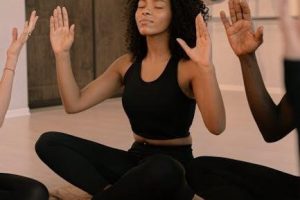
A 60-minute yoga sequence offers a balanced practice‚ enhancing energy and vitality while incorporating Ayurvedic principles. Ideal for teachers and practitioners‚ it provides structured flows for holistic well-being.
Overview of the Importance of Structured Yoga Practices
Structured yoga practices‚ like a 60-minute sequence‚ ensure a balanced and intentional flow‚ promoting physical‚ mental‚ and emotional harmony. These sequences guide practitioners through a logical progression‚ from warm-up to cool-down‚ enhancing safety and effectiveness. For teachers‚ especially newcomers‚ structured practices provide clarity and confidence‚ helping them manage class timing and student engagement. Students benefit from a cohesive experience‚ as each pose builds on the previous one‚ fostering strength‚ flexibility‚ and mindfulness. A well-designed sequence‚ such as the 60-minute Brahmana Vinyasa Flow‚ also aligns with Ayurvedic principles‚ supporting energy management and overall well-being. This approach ensures a transformative and grounding practice for all levels.
Benefits of a 60-Minute Yoga Class
A 60-minute yoga class offers a comprehensive practice‚ combining physical postures‚ breathing techniques‚ and relaxation. It enhances flexibility‚ strength‚ and cardiovascular health while reducing stress and anxiety. This duration allows for a balanced flow‚ incorporating warm-up‚ dynamic movements‚ and cooling poses‚ ensuring a holistic experience. Regular practice improves focus‚ posture‚ and overall well-being. The structured sequence also supports energy management‚ aligning with Ayurvedic principles. For teachers‚ it provides a clear framework to guide students through a transformative practice‚ catering to all levels and promoting mindfulness. This makes a 60-minute class ideal for both personal growth and teaching purposes.
How to Use a 60-Minute Yoga Sequence PDF
A 60-minute yoga sequence PDF serves as a valuable tool for planning and guiding classes. Teachers can use it to structure practices‚ ensuring a balanced flow of poses‚ breathing techniques‚ and relaxation. The PDF often includes detailed instructions‚ timing‚ and modifications‚ making it accessible for all levels. Practitioners can follow the sequence for home practice‚ while teachers can share it with students for consistency. Many PDFs also pair with audio classes‚ enhancing the experience. By using a 60-minute yoga sequence PDF‚ you can create a cohesive and transformative practice‚ tailored to energy management and holistic well-being‚ perfect for both personal and teaching purposes.
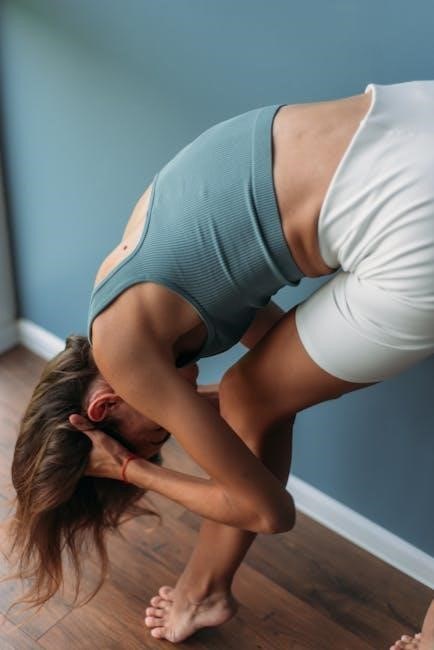
Understanding the Structure of a 60-Minute Yoga Class
A 60-minute yoga class typically includes a 10-minute warm-up‚ 30 minutes of dynamic flow and peak poses‚ and a 20-minute cool down with relaxation and Savasana.
Breaking Down the Class into Segments
A 60-minute yoga class is thoughtfully divided into three main segments to ensure a balanced practice. The first 10 minutes focus on warm-up and preparation‚ preparing the body for movement. The next 30 minutes are dedicated to dynamic flow and peak poses‚ building intensity and exploring challenging postures. The final 20 minutes are reserved for cool down‚ relaxation‚ and Savasana‚ allowing the body to unwind and rejuvenate. This structure ensures a holistic experience‚ blending physical postures‚ breathwork‚ and relaxation‚ making it suitable for all levels of practitioners.
Warm-Up and Preparation (10 Minutes)
The warm-up is essential to prepare the body for practice‚ lasting about 10 minutes. It begins with gentle movements like neck rolls‚ shoulder stretches‚ and wrist rotations to release tension. Sun salutations are often included to awaken the body and boost circulation. Breathing techniques‚ such as alternate nostril breathing‚ are introduced to center the mind. Gentle seated or standing poses‚ like cat-cow or forward folds‚ further loosen the muscles. This segment sets the foundation for the practice‚ ensuring safety and readiness for more dynamic movements. It’s a crucial step to prevent injury and enhance the effectiveness of the sequence.
Dynamic Flow and Peak Poses (30 Minutes)
This segment builds energy and intensity‚ lasting 30 minutes. It combines dynamic flows‚ such as Vinyasa sequences‚ to link movement with breath. Standing poses like Warrior II and Triangle Pose strengthen and balance the body. Backbends‚ like Cobra or Camel Pose‚ open the chest and improve flexibility. Peak poses‚ such as Crow Pose or Headstand‚ challenge students and deepen practice. The flow is designed to gradually increase intensity‚ preparing the body for the climax of the sequence. Proper alignment and breathing are emphasized to ensure safety and maximize benefits. This dynamic phase leaves students energized and ready for relaxation.
Cool Down‚ Relaxation‚ and Final Savasana (20 Minutes)
This 20-minute segment focuses on unwinding and relaxation after the dynamic flow. Start with gentle stretches‚ such as Seated Forward Bend and Child’s Pose‚ to release tension. Incorporate cooling postures like Seated Spinal Twist and Reclined Pigeon to calm the nervous system. Transition to the floor for supine poses‚ like Legs-Up-The-Wall or Reclined Goddess‚ to relax the spine and lower body. Conclude with 5-10 minutes of Savasana (Corpse Pose)‚ using props for comfort. Guide students through deep breathing exercises to promote relaxation. End with a gentle awakening‚ leaving students refreshed and centered. Soothing music enhances this calming phase.
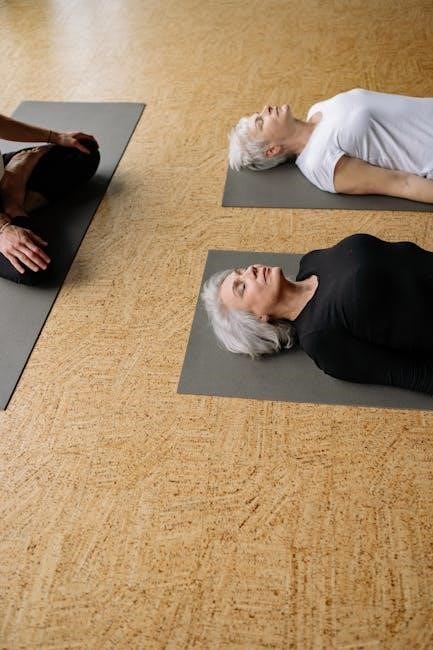
Key Considerations for Creating a 60-Minute Yoga Sequence
Balance‚ intention‚ and variety are essential. Ensure a logical flow‚ proper alignment‚ and modifications for all levels. Adapt to class dynamics while maintaining a holistic‚ transformative experience.
Aligning the Sequence with Ayurvedic Principles
Aligning your 60-minute yoga sequence with Ayurvedic principles enhances its effectiveness. Consider the three doshas (Vata‚ Pitta‚ Kapha) and tailor postures‚ breathing‚ and timing to balance them. For Vata‚ focus on grounding poses like Mountain and Tree postures. Pitta benefits from cooling postures such as Seated Forward Fold and Moon Salutations. Kapha responds well to invigorating flows like Sun Salutations. Timing is also crucial—practice during the Kapha time (morning) for energy or Pitta time (midday) for clarity. Incorporate Ayurvedic breathing techniques like Bhramari for calming or Kapalabhati for invigoration. End with meditation to harmonize the doshas‚ ensuring a balanced practice.
Incorporating Breathing Techniques (Pranayama)
Incorporate Pranayama‚ or breath control‚ to deepen your 60-minute yoga practice. Begin with Ujjayi (ocean breath) to calm the mind. Transition into Nadi Shodhana (alternate nostril breathing) to balance energy. Include Bhramari (bee breath) for stress relief. Kapalabhati (breath of fire) can energize the body. Sitali (cooling breath) and Sitkari (hissing breath) are ideal for hot days. Integrate these techniques during warm-up‚ between flows‚ or before final relaxation. Allocate 5-10 minutes for Pranayama‚ ensuring smooth transitions. This enhances focus‚ calms the nervous system‚ and prepares the body for deeper postures and meditation‚ making your practice holistic and transformative.
Balancing Yin and Yang Energies
Balancing Yin and Yang energies in a 60-minute yoga sequence harmonizes opposites‚ fostering equilibrium. Yin practices focus on passive‚ cooling postures‚ while Yang emphasizes dynamic‚ warming flows. Alternate between Yin holds for deep release and Yang movements for vitality. Incorporate restorative poses for Yin and flowing Vinyasa for Yang. This balance regulates energy flow‚ calms the mind‚ and strengthens the body. Timing is key—dedicate equal time to both‚ ensuring a holistic practice. This approach enhances flexibility‚ strength‚ and mental clarity‚ leaving practitioners refreshed and centered. It’s essential for maintaining overall well-being and creating a sustainable practice.
Modifications for Different Skill Levels
Modifications ensure inclusivity in a 60-minute yoga sequence‚ catering to diverse skill levels. Beginners can use blocks‚ straps‚ or knees-down alternatives for poses like downward dog or plank. Intermediate practitioners can deepen stretches or hold poses longer. Advanced students might explore complex flows or deeper twists. Offer options for seated or standing postures and provide alternatives for inversions. Encourage props like blankets or bolsters for support. Verbal cues guide students to honor their bodies‚ ensuring a safe and adaptable practice for all. This approach fosters progression and inclusivity‚ making the sequence accessible and beneficial for every level of practitioner.
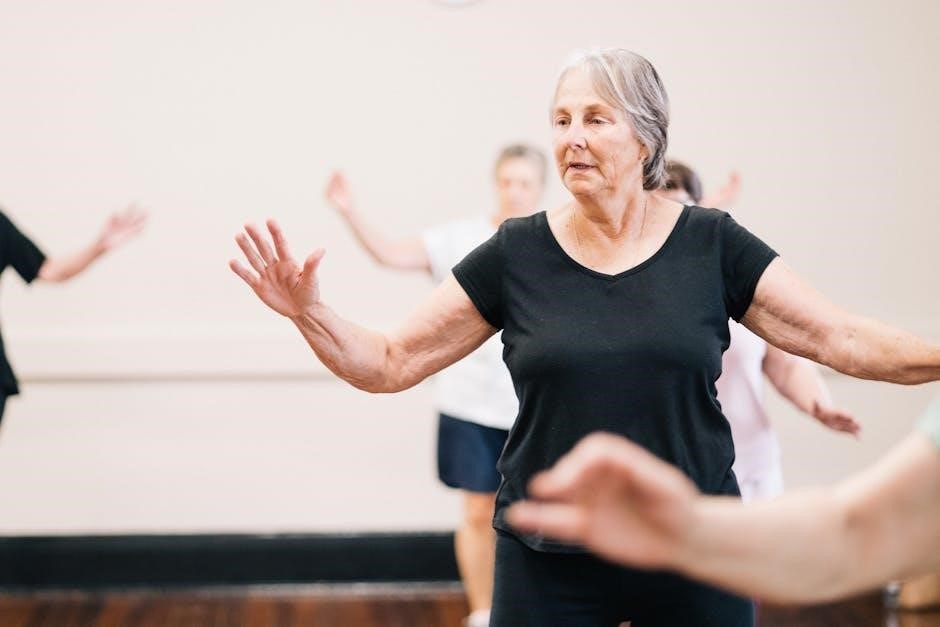
Popular Yoga Styles for a 60-Minute Sequence
A 60-minute yoga sequence can incorporate various styles like Hatha‚ Vinyasa‚ Ashtanga‚ or Restorative Yoga. Each style offers unique benefits‚ from structured postures to dynamic flows and deep relaxation‚ ensuring a well-rounded practice for all levels.
Hatha Yoga: Focus on Classical Postures
Hatha Yoga emphasizes traditional postures (asanas) and breathing techniques (pranayama)‚ creating a balanced practice. In a 60-minute sequence‚ Hatha Yoga typically begins with a gentle warm-up‚ followed by a series of classical poses like Mountain‚ Cobra‚ and Seated Forward Bend. Each posture is held for several breaths to promote alignment‚ strength‚ and flexibility. The practice also incorporates seated pranayama exercises‚ such as Alternate Nostril Breathing‚ to calm the mind and prepare for meditation. This style is ideal for beginners and experienced practitioners alike‚ offering a meditative and grounding experience. Props like blocks and straps can be used to make poses more accessible.
Vinyasa Flow: Linking Movement with Breath
Vinyasa Flow is a dynamic yoga style that synchronizes movement with breath‚ creating a flowing sequence. In a 60-minute class‚ students transition smoothly between poses‚ linking inhales and exhales to actions like rising or folding. Key poses include Plank‚ Chaturanga‚ and Upward-Facing Dog‚ often repeated in sequences. This practice builds internal heat‚ improves cardiovascular health‚ and enhances flexibility. Modifications‚ such as holding poses or using props‚ accommodate all levels. The continuous flow fosters mindfulness and connection to the breath‚ making it a transformative and meditative experience. Vinyasa Flow is ideal for those seeking a balanced practice that combines physical movement with mental focus.
Ashtanga Yoga: A Fast-Paced‚ Structured Approach
Ashtanga Yoga is a traditional‚ fast-paced style with a set sequence of postures. In a 60-minute class‚ students follow the Primary Series‚ focusing on detoxification and strength; Each pose is held for five breaths‚ synchronized with Vinyasa (movement linked to breath). The practice builds internal heat‚ improves circulation‚ and enhances physical and mental stamina. It’s ideal for those who enjoy structure and challenge. The sequence is rigorous‚ requiring mindfulness and discipline. Modifications are minimal‚ emphasizing traditional alignment. Ashtanga Yoga is perfect for experienced practitioners seeking a dynamic‚ transformative practice that fosters consistency and deep physical awareness.
Restorative Yoga: Emphasizing Relaxation
Restorative Yoga focuses on deep relaxation and rejuvenation‚ using props to support the body in calming postures. In a 60-minute sequence‚ 3-5 poses are held for 5-10 minutes each‚ allowing the body to release tension and restore energy. Bolsters‚ blankets‚ and straps are essential for comfort and alignment. The slow-paced practice reduces stress‚ enhances flexibility‚ and promotes mindfulness. It’s ideal for all levels‚ especially those seeking relaxation or recovering from injury. The sequence encourages stillness‚ breath awareness‚ and surrender‚ creating a meditative experience. Props are tailored to individual needs‚ ensuring a safe and nurturing environment for restoration.
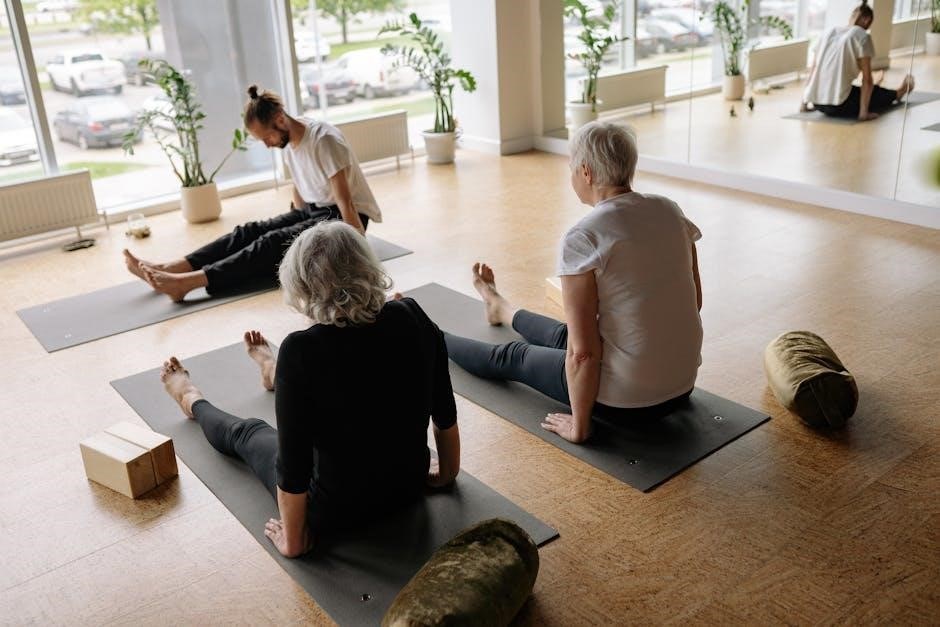
Essential Poses for a 60-Minute Sequence
A 60-minute yoga sequence includes foundational standing poses‚ seated postures‚ backbends‚ inversions‚ and forward folds. These poses enhance strength‚ balance‚ flexibility‚ and mental focus‚ creating a balanced practice.
Foundational Standing Poses
Foundational standing poses form the backbone of a 60-minute yoga sequence‚ establishing grounding and alignment. Mountain Pose (Tadasana) sets the foundation‚ while Downward Dog (Adho Mukha Svanasana) stretches the hamstrings and spine. Warrior I (Virabhadrasana I) and Warrior II (Virabhadrasana II) build strength and stamina. Triangle Pose (Trikonasana) enhances balance and flexibility‚ and Tree Pose (Vrksasana) cultivates focus and stability. These poses prepare the body for dynamic flows and more complex postures‚ ensuring proper alignment and engagement. They are essential for creating a strong‚ balanced practice and setting the tone for the entire sequence.
Seated Postures for Flexibility and Strength
Seated postures in a 60-minute yoga sequence enhance flexibility and build strength‚ particularly in the hips‚ spine‚ and legs. Seated Forward Fold (Paschimottanasana) stretches the hamstrings and lower back‚ while Seated Cobra (Bhujangasana) strengthens the chest and shoulders. Cat-Cow Pose (Marjaryasana-Bitilasana) warms up the spine‚ improving mobility. Seated Spinal Twist (Bharadvajasana) detoxifies and balances the body. These postures also prepare for deeper stretches and strengthen core muscles‚ making them essential for a balanced practice. Incorporating props like blocks or straps can help modify poses for accessibility‚ ensuring all levels benefit from these transformative seated postures.
Backbends and Heart-Opening Poses
Backbends and heart-opening poses are integral to a 60-minute yoga sequence‚ fostering flexibility‚ strength‚ and emotional release. Cobra Pose (Bhujangasana) and Cat-Cow Pose (Marjaryasana-Bitilasana) gently warm up the spine‚ while deeper backbends like Camel Pose (Ustrasana) and Wheel Pose (Urdhva Dhanurasana) open the chest and shoulders. These poses enhance posture‚ reduce upper back tension‚ and promote confidence. Heart-opening exercises‚ such as Supported Fish Pose (Matsyasana) with a block‚ encourage emotional openness and balance. Incorporating these poses mid-sequence helps build energy and prepares the body for peak poses‚ creating a harmonious flow of strength and flexibility.
Inversions for Balance and Inversion Benefits
Inversions like Downward-Facing Dog (Adho Mukha Svanasana) and Legs-Up-The-Wall Pose (Viparita Karani) promote balance‚ calmness‚ and circulation. These poses invert the body‚ reversing blood flow and rejuvenating the mind. Headstand (Sirsasana) and Handstand (Adho Mukha Vrksasana) build strength and confidence‚ while gentle inversions like Bridge Pose (Setu Bandha Sarvangasana) offer milder benefits. Incorporating inversions in a 60-minute sequence enhances equilibrium‚ energizes the body‚ and prepares for deeper relaxation. Proper alignment and modifications‚ such as using walls or props‚ ensure safety and accessibility for all levels‚ making inversions a valuable addition to any practice.
Forward Folds and Cooling Poses
Forward folds and cooling poses‚ such as Standing Forward Bend (Uttanasana) and Seated Forward Fold (Paschimottanasana)‚ stretch the hamstrings‚ spine‚ and hips while calming the nervous system. These poses promote introspection and relaxation‚ making them ideal for the latter part of a 60-minute sequence. Supine poses like Supta Baddha Konasana also cool the body and prepare for Savasana. Incorporating props like blocks or blankets ensures accessibility for all practitioners. These poses help transition into deeper relaxation‚ balancing the energy after dynamic flows and inversions‚ and are essential for restoring equilibrium in the body and mind.
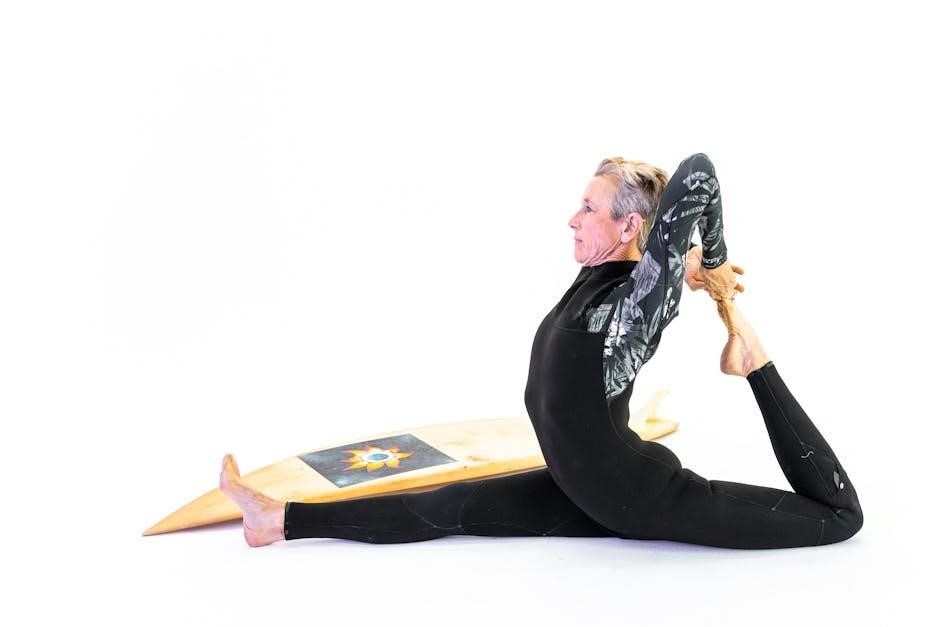
Timing and Pacing in a 60-Minute Class
Proper timing ensures a balanced practice‚ allowing seamless transitions and adequate pose holds. Adjust pacing to suit class dynamics‚ ensuring students experience both intensity and relaxation effectively.
Allocating Time for Each Segment
A well-structured 60-minute yoga sequence allocates time thoughtfully across segments. Dedicate the first 10 minutes to warm-up‚ preparing the body for movement. The next 30 minutes focus on dynamic flow and peak poses‚ building intensity. The final 20 minutes are reserved for cool down‚ relaxation‚ and Savasana‚ allowing the body to unwind. Proper timing ensures each phase is balanced‚ promoting physical preparation‚ energetic engagement‚ and deep relaxation. This allocation supports a holistic practice‚ catering to both physical and mental well-being.
Transitioning Smoothly Between Poses
Smooth transitions between poses are key to maintaining flow and safety in a 60-minute yoga sequence. Encourage students to move with intention‚ using breath awareness to guide their movements. Provide clear cues for inhalation and exhalation to signal transitions‚ ensuring alignment and stability. Instructors should pace the class dynamically‚ offering modifications to suit all levels. This approach fosters a meditative atmosphere‚ prevents injuries‚ and enhances the overall experience. Thoughtful transitions create a seamless practice‚ allowing students to focus on their journey and connect deeply with their breath and body. Proper sequencing ensures a harmonious and transformative yoga practice.
Adjusting the Sequence for Class Dynamics
Class dynamics play a crucial role in shaping a 60-minute yoga sequence. Instructors should observe the energy and experience levels of students to tailor the practice. For a dynamic class‚ incorporate more flowing sequences and challenging poses. For a calm atmosphere‚ emphasize grounding postures and relaxation. Encourage interaction by offering modifications and adjustments. Use feedback to gauge the group’s needs and adapt the sequence accordingly. This ensures the practice remains engaging‚ accessible‚ and beneficial for all participants‚ fostering a sense of community and shared growth. Flexibility in sequencing allows for a more personalized and impactful yoga experience.
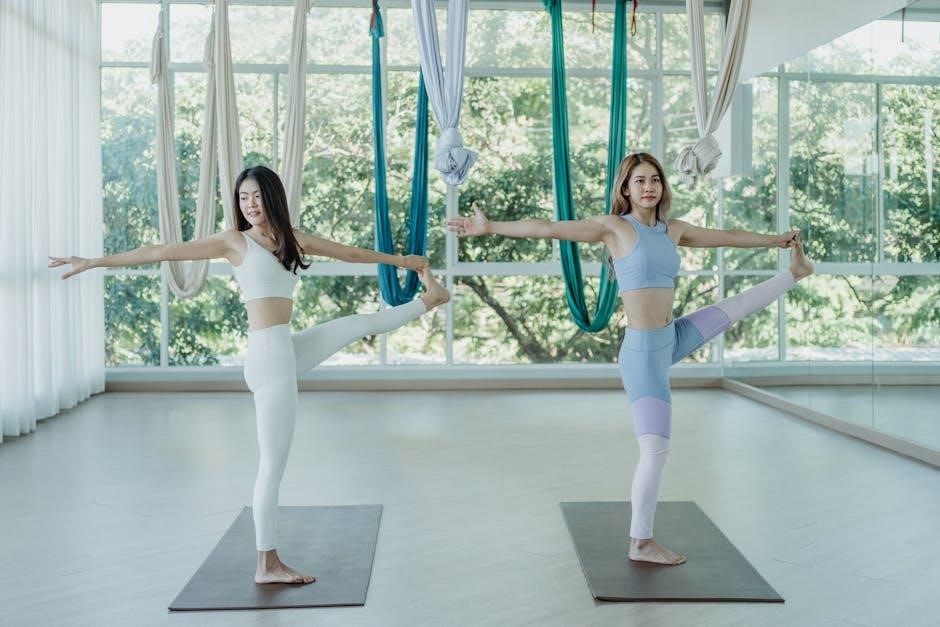
Using Music and Props in a 60-Minute Sequence
Music and props enhance the yoga experience‚ creating a balanced atmosphere; Use calming melodies for relaxation and dynamic beats for flows. Incorporate blocks‚ straps‚ and bolsters to improve alignment and accessibility‚ ensuring all students can participate comfortably. This combination fosters a harmonious and inclusive practice environment.
Selecting Appropriate Music for Each Segment
Choose music that aligns with the energy of each segment. Start with calming tracks for warm-ups to set a meditative tone. Transition to uplifting‚ rhythmic beats during dynamic flows to enhance movement and breath synchronization. For peak poses‚ opt for inspiring or neutral music to maintain focus. During cool down and Savasana‚ select soothing‚ ambient sounds to promote relaxation. Consider tempo‚ volume‚ and mood to match the practice’s intensity. Using curated playlists or mixing genres can create a seamless experience. Ensure music complements the practice without overpowering it‚ allowing students to remain present and fully engaged in their yoga journey.
Integrating Props for Better Alignment
Props such as blocks‚ straps‚ blankets‚ and bolsters are invaluable for enhancing alignment and accessibility in a 60-minute yoga sequence. Use blocks to support hands in standing poses or under the pelvis in seated postures. Straps can deepen stretches or assist in maintaining proper spinal alignment. Blankets provide cushioning for joints and support the spine in seated twists. Bolsters are ideal for restorative poses‚ promoting relaxation and proper breathing. Introduce props early in the practice to encourage students to use them mindfully‚ ensuring a safe and alignment-focused experience throughout the sequence.
Enhancing the Experience with Ambient Sound
Ambient sound plays a crucial role in creating a immersive yoga experience. Soft instrumental music‚ nature sounds‚ or chanting can set the tone for relaxation and focus. Calming melodies during the warm-up help students connect with their breath‚ while uplifting rhythms can energize the dynamic flow. Incorporate mantras or drum beats during peak poses to elevate energy. For Savasana‚ use soothing sounds like rain or Tibetan bowls to deepen relaxation. Silence can also be powerful‚ allowing students to internalize their practice. Thoughtfully curated ambient sound enhances the emotional and meditative dimensions of the sequence‚ fostering a holistic yoga experience.
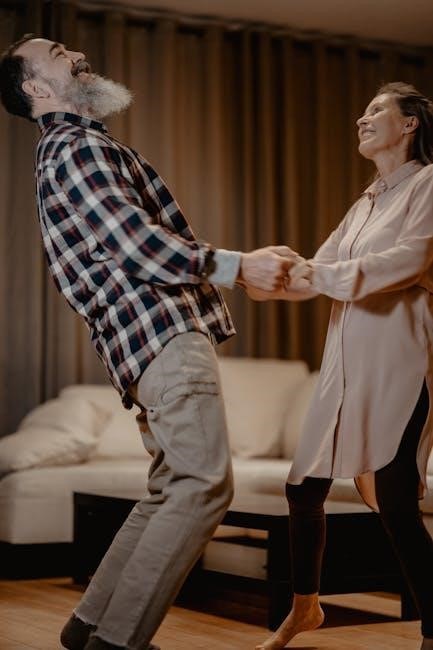
Modifications and Variations for All Levels
Offer modifications for each pose to suit beginners‚ intermediate‚ and advanced practitioners. Use props for support and provide optional advanced variations. Include alternatives for injuries or pregnancies to ensure inclusivity and accessibility for all students.
Accommodating Beginners in a 60-Minute Class
When accommodating beginners in a 60-minute yoga class‚ focus on foundational poses and clear instructions. Use props like blocks‚ blankets‚ and straps to support proper alignment and accessibility. Offer modifications for complex poses‚ ensuring students feel comfortable and safe. Provide ample time for transitions and encourage a slower pace to allow beginners to acclimate. Include rest periods or child’s pose to recharge energy. Emphasize breath awareness and basic breathing techniques to build a strong foundation. Encourage questions and create a welcoming environment‚ fostering confidence and curiosity for new practitioners.
Challenging Advanced Practitioners
For advanced practitioners‚ incorporate complex poses‚ deeper holds‚ and dynamic flows to push their limits. Introduce advanced inversions‚ arm balances‚ and twists‚ ensuring proper alignment and engagement. Incorporate pranayama techniques like Kapalabhati or Surya Bhedana for enhanced breath awareness. Include longer holds in peak poses to build endurance and strength. Offer creative vinyasa sequences to challenge coordination and focus. Encourage self-awareness and precise alignment to refine their practice. Use props like benches or walls to deepen poses safely. Provide opportunities for exploration and innovation‚ allowing advanced students to expand their practice and reach new levels of mastery.
Incorporating Prenatal or Therapeutic Modifications
For prenatal yoga‚ modify poses to support the body during pregnancy‚ such as substituting deep twists with gentle‚ supported side bends. Avoid deep backbends‚ supine poses‚ and abdominal compression after the first trimester. Use props like bolsters or pillows for comfort. For therapeutic yoga‚ tailor the sequence to address specific needs‚ such as chronic pain or limited mobility. Offer alternatives like seated forward folds instead of standing‚ or gentle flows to avoid strain. Emphasize breath awareness and relaxation‚ ending with restorative poses to promote healing and calm. Ensure modifications are clear and safe‚ maintaining the sequence’s flow and beneficial effects.

Sequencing Principles for a 60-Minute Practice
A well-structured 60-minute yoga sequence begins with a logical flow‚ progressing from foundational poses to peak postures‚ ensuring a balanced practice that enhances physical and mental wellness. Proper warm-up and cool-down periods are essential to prepare the body and promote relaxation. Each segment should seamlessly transition to maintain engagement and alignment with the sequence’s intent‚ fostering a cohesive and transformative experience for all practitioners.
Building a Logical Flow of Poses
Building a logical flow of poses in a 60-minute yoga sequence ensures a balanced and transformative practice. Start with foundational postures to establish alignment and prepare the body for movement. Gradually progress to dynamic flows‚ linking breath with motion to build internal heat and flexibility. Include peak poses that challenge strength‚ balance‚ or flexibility‚ ensuring proper preparation and transitions. Conclude with cooling poses to calm the nervous system and promote relaxation. This structured approach honors the body’s natural progression‚ prevents injury‚ and enhances the overall benefits of the practice. Logical sequencing creates a cohesive experience‚ guiding students toward physical‚ mental‚ and emotional harmony.
Creating a Peak Pose Sequence
Creating a peak pose sequence involves designing a series of poses that culminate in a challenging or transformative posture. Begin by preparing the body with foundational poses that target the necessary muscle groups and improve flexibility. Gradually build intensity with dynamic flows or strength-building postures. The peak pose should be approached with proper alignment and breath awareness to enhance safety and effectiveness. Include modifications and props to make the sequence accessible. Conclude with counterposes to balance the body and release tension. A well-structured peak sequence challenges students while fostering growth and confidence in their practice.
Ensuring Proper Warm-Up and Cool Down
A proper warm-up sets the foundation for a safe and effective practice‚ gradually increasing blood flow and flexibility. Dedicate 5-10 minutes to gentle movements like neck rolls‚ shoulder stretches‚ and cat-cow sequences. Sun salutations or leg swings can prepare major muscle groups. The cool down‚ lasting 5-10 minutes‚ guides the body back to rest with forward folds‚ seated stretches‚ or supine poses. End with Savasana to calm the nervous system. Balancing these segments ensures a holistic practice‚ preventing injury and promoting relaxation. A thoughtful warm-up and cool down enhance the overall experience and foster long-term well-being for all practitioners.
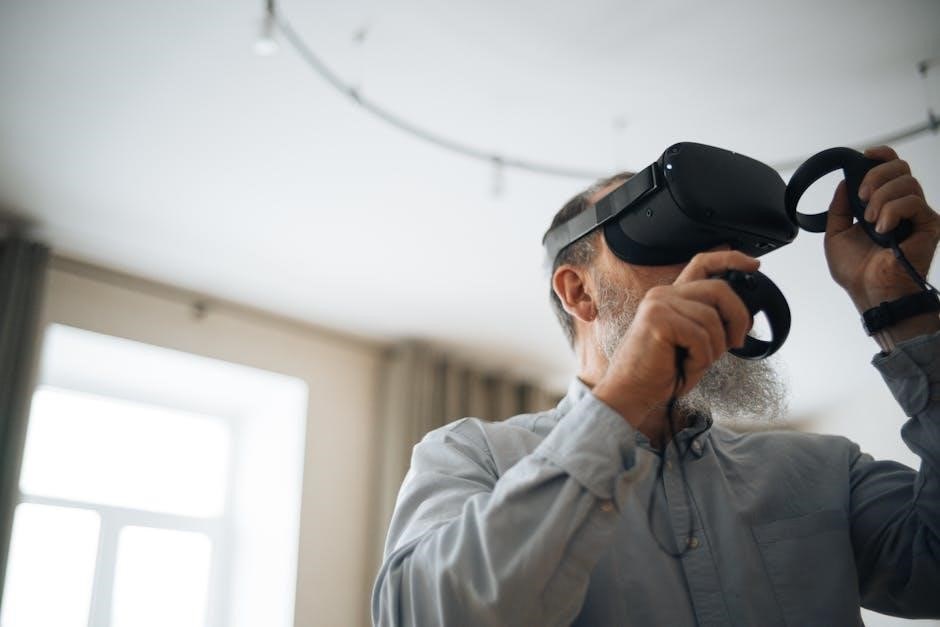
Finalizing and Sharing Your 60-Minute Sequence
Ensure your sequence flows logically‚ with clear instructions and timing. Share as a PDF‚ incorporating visuals and tips for students. Distribute digitally or in class.
Creating a PDF Guide for Students
A comprehensive PDF guide enhances student practice by providing a clear‚ structured sequence. Include an overview‚ pose images‚ and step-by-step instructions. Add timing for each segment and modifications for different skill levels. Highlight tips and benefits of each pose to deepen understanding. Use bullet points and visuals for easy reference‚ ensuring the guide is both informative and visually appealing. This resource empowers students to practice independently and confidently‚ reinforcing their learning and engagement with the 60-minute sequence.
Pairing the Sequence with an Audio Class
Enhance the practice by pairing your 60-minute yoga sequence PDF with an audio class. Record a corresponding voice guide that aligns with the poses‚ timing‚ and breathing techniques outlined in the PDF. Include soft background music to create a calming atmosphere. Provide a link to the audio file alongside the PDF for easy access. This combination allows students to follow verbal cues while referencing the visual guide‚ ensuring a seamless and immersive practice experience at home or in the studio. Synchronize the audio with the sequence for a cohesive and engaging yoga practice.
Receiving Feedback and Refining the Sequence
After sharing your 60-minute yoga sequence PDF‚ gather feedback from students and peers to refine and improve the practice. Conduct surveys or hold post-class discussions to understand what resonates and what needs adjustment. Pay attention to comments on pacing‚ pose difficulty‚ and overall flow. Use this feedback to tweak the sequence‚ ensuring it meets diverse needs. Consider testing the revised sequence in a live class to observe its effectiveness. Iterate on the design until it feels balanced and engaging for all participants. Continuous refinement ensures the sequence remains dynamic and beneficial for ongoing practice.